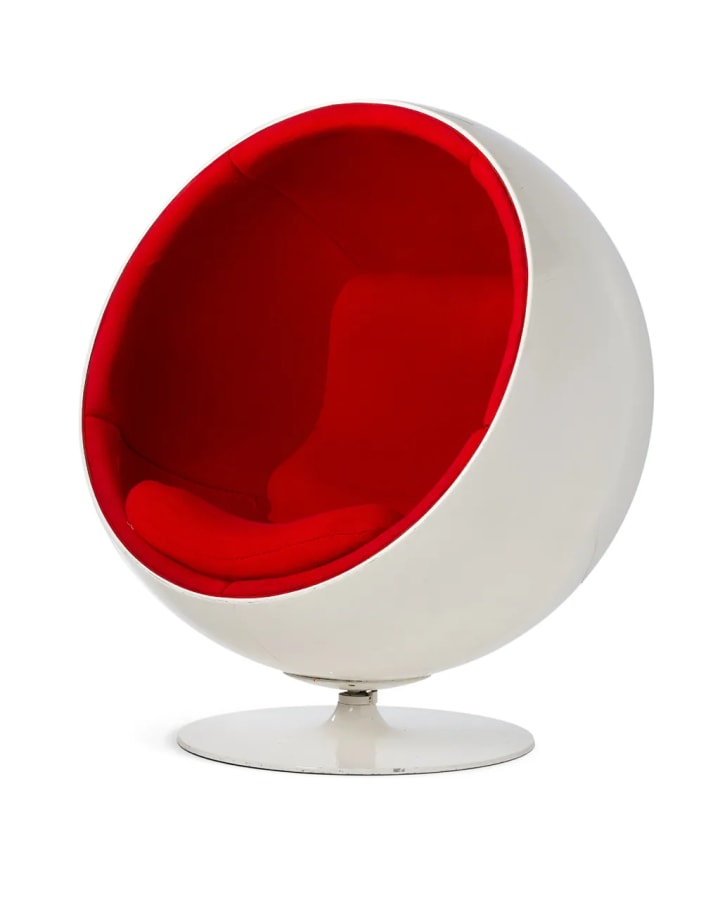
t is impossible to underestimate the enormous impact that plastic has had on our daily lives over the past century or so. The expansion of global communications, the electrification of our homes and space exploration would have all been unthinkable without it. The streamlined aesthetic of the 1930s and the futuristic shapes of the 60s would have taken very different forms. Yet a product once associated with progress and revolutionary design potential is now considered toxic, polluting our oceans and causing untold damage to marine and human health. In the exhibition Plastic: Remaking Our World, the Vitra Design Museum explores how plastic became so omnipresent, and encourages us to think about more considerate production and use. The Stedelijk Museum in Amsterdam is also addressing the issue in It's Our F***ing Backyard, which looks at products already on the market as well as experimental works.
More like this:
- What the Nordics can teach us about fun
- Why the tiny house is perfect for now
- What your sneakers say about you
Given the impact of plastic on the current global climate crisis, it may come as a surprise that its earliest forms were actually created in order to protect nature. "They were all to be substitutes for natural materials that had become either scarce and/or expensive, or the harvesting or extraction of which really posed a threat to nature," explains Jochen Eisenbrand, chief curator at the Vitra Design Museum.

Celluloid, for example, was initially invented as an alternative to ivory, which was in high demand for billiard balls during the 19th Century. The fact that it was also remarkably flexible and transparent when produced in thin strips meant that it went on to radically impact the photographic industry, leading to the development of photographic film and, ultimately, motion pictures.
Featured in films and on the covers of numerous magazines, the spherical Pallo chair became one of the most iconic designs of the 1960s
Bakelite was the first truly synthetic material, invented in 1907 by Leo Bakeland. "One of the reasons it became so popular so quickly was its electrical insulating properties," Eisenbrand tells BBC Culture. "The 1920s was the beginning of the electrification of households, and that would have been unthinkable without a fairly cheap, industrial material that could be used for light switches, sockets and of course the early electric appliances that appeared such as radios, telephones and loud speakers.".
This early plastic industry was very much a demand-driven one. However, as the understanding of polymer science expanded in the 1920s and 30s, chemists at major petrochemical companies began to create new materials from by-products, simply because they could, leading to the appearance of substances such as polystyrene, polyvinyl, nylon, and Teflon.
The outbreak of World War Two was the catalyst for the plastic industry to expand. With a need to conserve strategic materials such as rubber, silk, and steel, the plastics industry was leaned on for alternatives. Nylon was used for parachutes, mosquito nets and hammocks. Polyethylene proved to be both lightweight and an excellent insulator of electrical current, making it the ideal material for mobile radar stations light enough to be carried in aircraft, while the acrylic glass which had been created in the 1930s was used in the canopies of planes, being less harmful to pilots if it shattered.

From 1939 to 1945, plastic production quadrupled from around 100 million kg per year to almost 400 million kg per year in the US. After the war, this newly-thriving industry with a vastly increased production capacity saw no reason to scale back, and the peace-time consumer was its obvious target. With the petrochemical industry now a major player, "it changed from this demand-driven industry to supply driven," says Eisenbrand. "Every year new plastics were invented without the industry knowing what to do with it, so they employed designers to find applications."
The idea of a "wipe-clean world" entered the vocabulary, with formica counters and vinyl wallpapers being hygienic and easily cleaned. The refrigerators that were entering more and more homes could be filled with Tupperware containers, while children could play with Barbie, Lego, the hula hoop and the frisbee. Vinyl records replaced the easily fractured shellac discs.
In the 60s, the space race inspired fashion designers such as Paco Rabanne and Pierre Cardin to use fabrics derived from plastics in their futuristic designs. These fabrics would also play a vital role in the first manned mission to the moon, with the Apollo spacesuit made up of more than 20 synthetic textiles, including nylon, Lycra, Neoprene, Mylar and Teflon.
Furniture designers made increasing use of this miraculous, malleable material that offered seemingly endless potential. Finnish designer Eero Aarnio came up with the spherical, swivelling Pallo Chair, a personal cocoon which came fitted with its own Ericsson phone. Featured in films and on the covers of numerous magazines, it became one of the most iconic designs of the 1960s.

Although more and more plastic was entering the marketplace, at this point it was still generally used in products that were intended to be kept for many years. The real problems began when, in a cynical search for new markets, the plastics industry came up with the idea of "disposables".
In the 1960s, there was this really positive vibe about plastics, and now we find this positive spirit in the many attempts to try to tackle the problem – Jochen Eisenbrand
"The future of plastics is in the trash can," declared Lloyd Stouffer, editor of Modern Packaging magazine, in 1956. Although a generation that came of age during the depression – and had endured wartime austerity – initially reacted with horror to the idea of simply throwing something away (it was not uncommon for people to keep and re-use the plastic cups from early coffee vending machines), the idea of convenience soon took hold of the public imagination. And then, in 1973, Du Pont engineer Nathaniel Wyeth patented the first plastic bottle created from polyethylene terephthalate, commonly known as PET.
Rising to the challenge
The disposable culture that this one item, in particular, has come to symbolise has undoubtedly tarnished the image of plastics to such an extent that it is easy to forget the material still has many positive uses. An essential component in much medical equipment, its lightness also means that when used in aircraft production it helps to reduce fuel consumption.
The organisers of Plastic: Remaking Our World freely acknowledge the naivety of thinking that we will ever live in a world without plastics. Instead, they highlight the urgent need to recognise precisely where the material is essential, while simultaneously reducing – and ultimately eliminating – its use where it is not. The constructive re-use of plastics already in circulation, and the development of alternatives, must also form part of the equation.
Fortunately, many designers and manufacturers appear to be rising to the challenge. "In the 60s, there was this really positive vibe about plastics because of everything they enabled, and now we find this positive spirit in the many attempts to try to tackle the problem. So many designers are doing material research. Scientists are working with enzymes that can break down plastics, manufacturers are taking action, not only for the greenwashing but because they know there is a problem, and that they need to act," says Eisenbrand.

This positive vibe is in evidence at the Stedelijk's exhibition which, in addition to experimental products and projects, is exhibiting items already on the market to highlight the role individuals can play in tackling the crisis via their purchasing choices. "We can talk about really big industry and what we have to change, but for us it was also important that visitors and consumers can think about what small changes they can make," says curator Amanda Pinatih.
Many of the products on view make thoughtful and inventive use of recycled plastics. The Ocean Bottle is not only made out of recycled plastic bottles recovered from the sea, its sale also funds the collection of more bottles by local people in coastal areas. Aiming to tackle environmental awareness at an early age, the ecoBirdy range of chairs and tables for children are made out of recycled toys, which are still recognisable in the new products. Furniture for adults also tackles the problem, such as the Rex chair designed by Ineke Hans for the office manufacturer Ahrend, which is made from old office furniture, fishing nets, carpet and industrial waste. To guarantee that the product is recycled as far as possible at the end of its life, the producer offers to give owners 20 euros if they return it, making it possibly the world's first deposit chair.
The bigger the manufacturer, the bigger the impact. Ikea uses recycled PET plastic in everything from cushion stuffing to a simple series of storage boxes that the museum is displaying. "They know they haven't been great for the environment but they also know they have a really big platform – so they know that if they change, it can really make a difference," says Pinatih. Likewise, Adidas is aiming to make trainers as sustainable as possible with its Made to be Remade line. The trainers can be returned to the shop when they are worn out, and then shredded in order to provide material for the next batch of footwear.
Designers are also increasingly making use of alternatives to widely-used plastics. A surfboard by Studio Bart Vernooij is made from flax fibre and bio-based epoxy instead of the usual toxic fibreglass and synthetic resins, while Biotrem makes disposable tableware as environmentally friendly as it can possibly be. Created from pressed wheat bran and water, 10,000 fully compostable items can be produced from a single ton of wheat.
Many designers are also turning to historic techniques in order to provide sustainable goods for the future. Martijn Straatman has been exploring the potential of manure, once commonly used in the construction of buildings, to create environmentally-friendly interior products, and the museum is displaying one of his stools. Pinatih dismisses fears that such material could be off-putting. "It's a really fun design, and at least here in the Netherlands people try to find humour in things a lot – it's a real conversation starter," she says.

Experimental projects that use bioplastics are also on display, and Pinatih thinks some have real potential, such as the interior panels created by the architect and designer Mae-Ling Lokko. Made from repurposed agricultural waste and fungal mycelium, not only are the products eco-friendly but her practice also aims to counter the exploitation of land and its inhabitants.
It is clear that targeting our problem with plastic consumption is going to involve a multi-pronged attack that combines innovation with pragmatism, and requires the participation of consumers as well as scientists and designers. Let's hope these two exhibitions will encourage more to join the battle.






Comments
There are no comments for this story
Be the first to respond and start the conversation.